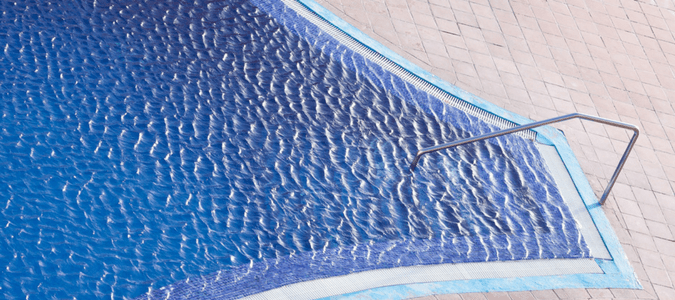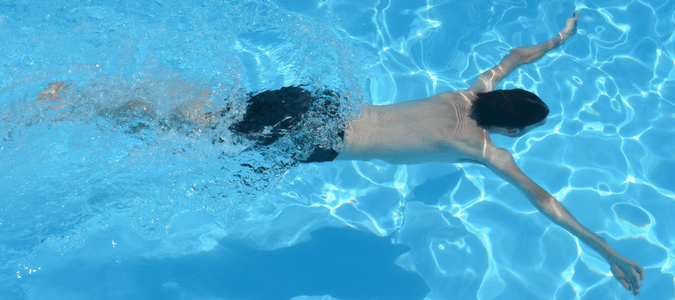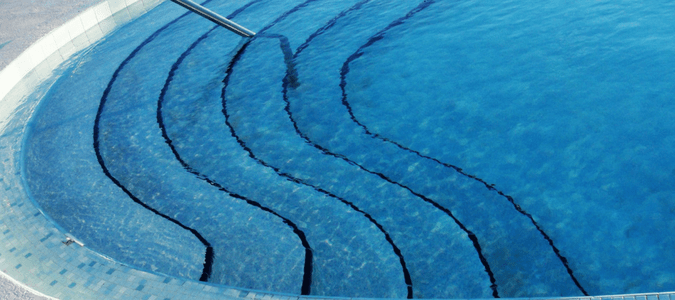
Your pool has become a gathering place where friends and family enjoy spending time together. You have invested time and energy over the years to maintain your swimming hole. Over time, however, you have noticed that the walls and bottom of your pool have become rough, bumpy, and even sharp in places.
Something needs to be done, but what? As pools age, the plaster used initially tends to get rough and make them unsightly and potentially dangerous. How do you fix the problem? By replastering.
Replastering a Pool: A Complete Guide
In a nutshell, replastering a pool means putting a new layer of plaster on the walls and bottom. What does plaster do?
First, it serves to make your pool waterproof. Kind of important, right?
When you installed your pool, the people who did it likely used concrete or gunite to form the “shell” of the pool. The problem with both of these substances is that they’re porous. That means that they don’t hold water over time.
If they left your pool as a concrete or gunite shell, it would periodically empty on its own, and you’d have to keep refilling it.
To avoid this problem, installers typically add a ½-inch-thick layer of plaster. Not only does plaster keep the water from draining out, it also makes the surfaces of the pool look and feel nice. A newly-plastered pool will be smooth, shiny, and blue.
Unfortunately, plaster doesn’t last forever. Depending on how much you use your pool and how well you clean and maintain it, pool plaster can remain viable for anywhere from seven to 20 years.
If you’re approaching that “danger” range and the pool is starting to look and feel rough, it’s probably time to replaster.

What are the risks if you ignore the problem? You can probably already guess some of them, but let’s go down the list:
You’ll get stains. Over time, certain minerals that may be present in your water, such as iron and copper, can cause the plaster to stain. These stains will make the water and the pool look dingy, dirty green or brown.
Ultimately, this is just an aesthetic problem, but that doesn’t mean it’s not a big deal. You likely spent a lot of money installing your pool, and you’ve continued spending to keep it looking and working its best. It can be frustrating if you have to deal with a stained, dirty-looking pool after all of that.
It’s important to note that the kinds of stains that call for replastering typically take many years to show. If you notice stains in one or two places after only a year or two, that is likely due to a different problem, and you definitely need to bring someone in to look at it and shore up those spots.
The surface can become uncomfortable. We’ve mentioned lumps, bumps, and scratchiness, but it bears repeating. No one wants to jump into a pool and scrape their foot, knee, or hand because the plaster has worn away and left rough, painful spots.
Depending on how your plaster wears away, you might be dealing with bumpy, uneven surfaces or rough ones. Bumpy may not seem so bad, but it can still be uncomfortable to walk, sit or lean on, and the lumps can make the pool harder to clean and more accessible for algae to find a welcoming surface. And rough surfaces can cut you and snag and tear at bathing suits and other items in the water.
It can compromise the structural integrity of the pool. Ultimately, this is the most significant danger. Remember, one of the most giant plaster jobs is to waterproof the pool. Right underneath that half-inch waterproof layer is porous gunite or concrete. If the plaster wears through in spots, water will seep into this “shell” and can cause significant problems over time.
While it is possible to patch areas that wear through individually (even while the pool is still complete!), this is generally seen as a stop-gap measure. The plaster will continue to wear down on the rest of the pool surface, and the areas you patch will always be noticeable.
Basically, if the surface of your pool feels rough or bumpy or if you notice the “shell” materials peeking through, it’s time to think about replastering.

Is There An Alternative To Replastering A Pool?
If replastering your pool sounds like a big project, you might wonder if there is a way to avoid it. The short answer is that you have several other options. Unfortunately, most are temporary fixes or even more expensive. Let’s go over each one.
Patching. As mentioned above, you could patch your pool when you notice rough areas or places where the plaster has worn through. However, this is not only a temporary solution; it’s downright unsightly because the patch materials will never match the plaster.
Acid wash. This quick fix works for stains but not so much for plaster that’s wearing away. In fact, it actually makes your plaster wear away faster because it essentially takes off the top, stained layer. Use an acid wash only if aesthetics are really that important to you.
Tile. Want a solution that’s incredibly durable and striking in appearance? Are you not worried about the cost?
Tiling a pool can be a great decision. Compared to the other choices, tile lasts forever as long as you maintain it. Even better, it looks absolutely gorgeous, and you can create almost any design you imagine.
The downside is that tile is really, really expensive. How much are we talking about? Typically anywhere from $75-$100 per square foot. If you wanted to tile your entire pool surface, that would quickly get very expensive.
Paint. That’s right–paint. Years ago, pools didn’t use plaster at all. Pool builders used paint specially designed to stand up to the rigors of being underwater, the various chemicals that tend to be present in swimming pools, and the extremes of temperature.
The average cost to repaint a pool is about $5,000. It’s significantly less expensive to paint a pool, much easier to apply than plaster, and typically, it looks just as good.
So why don’t more people use paint today?
The main reason pool owners choose to replaster is that it can last up to 20 years. Pool paint jobs, in contrast, have far less longevity. In the absolute best situation, pool paint might hold up for seven years, but two or three is far more common, and pools used frequently need to be repainted annually.
When you break down the numbers, and the times you would likely need to paint your pool versus replastering it, the cost looks even more.
Moreover, a thin layer of paint can’t compare with a half-inch-thick layer of plaster in terms of durability. It will chip and wear away more efficiently, and you will need to repair it when it does.
If there’s a reason to use paint over plaster, the application process is a lot easier. While you could paint independently, replastering is something that only the most industrious homeowners take on. You’ll see why in a moment.

The Replaster Pool Process
Convinced that you need to replaster your pool, but wondering what is involved. Before we get into step-by-step instructions, let’s cover the basics.
First, you’ll want to gather all your needed materials, which is no small task. You will probably have some of the tools you’ll need, but you will probably go to multiple stores to get the rest. Then, you’ll need to drain your pool and remove any bubbling or loose plaster. Then you’ll need to sand down all the rough edges.
After you have a nice, uniform surface all along your pool, you’ll need to apply an acid wash and a bond coat, allowing time between each coat to dry. Then you’ll need to mix and apply two layers of plaster to the pool bottom and walls. You’ll need to apply a few layers of pool paint, let that dry, and then refill your pool.
Average Cost To Resurface Pool
You are trying to determine whether to replaster your pool or hire someone to do the job. Of course, costs vary depending on the part of the country in which you live, the condition of your pool, and other regional factors. Assuming your pool is about 120 square feet, you should budget about $200 for supplies and $500 for six hours of labor. That means your total cost will be about $700 for 120 square feet.
Steps to Replaster a Pool
You might decide you want to replaster your pool yourself in an attempt to save some money. Remember that it will take a lot of time and effort on your part because the replaster pool process is complex and prone to error.
Here’s what you’ll need to do it yourself:
- Acid wash
- Air compressor
- Air hammer
- Bond coat
- Brush for acid
- Buckets
- Chisel
- Cleaning solution (ecologically friendly)
- Face mask
- Finishing plaster mix
- Gloves
- Goggles
- Hammer
- Hose
- Marker
- Mixer (for cement or mortar)
- Paint
- Paintbrush
- Paint roller (rough one)
- Pool plaster mix
- Power trowel (stainless steel)
- Putty knife
- Rubber gloves
- Sander (a powerful one)
- Shovel
- Soda ash
- Sponge
- Sump pump (for submerging)
- Wheelbarrow
- Yard brush
Some of those you probably have on hand. Many of you likely don’t. A few may not even be familiar to you at all.
That doesn’t have to be a deal-breaker, though. Spend some time watching a few YouTube videos, and you should be able to get a general idea of both of the specific tools and how you’ll need to use them to replaster your pool.

Once you gather all your materials, you’ll want to follow these steps to replaster your pool:
Get the Pool Prepped
- Turn off any pool equipment.
- Drain the pool.
- Use the sump pump to get out any remaining water.
- Remove any loose debris, like leaves.
- Chisel away any plaster that has gotten loose.
- Sand down any edges that are sharp or rough.
- Use the cleaning solution and a sponge to clear away any remaining dirt.
Start the Pre-plastering Process
- Take your acid brush and spread the acid wash over the old plaster.
- Use a hose to rinse the acid wash-off. Make sure you are thorough.
- Allow the pool to dry.
- Apply a bond coat.
- Let the bond coat dry. This will take anywhere from 8 to 10 hours.
Prepare and Apply Plaster
- Read the manufacturer’s instructions, and mix the plaster accordingly.
- Starting at the deep end of the pool, use your trowel to apply a layer of plaster at least ⅜ of an inch thick. Make sure that the layer is smooth and that you fill in all cracks and holes.
- Allow the plaster to dry.
- Apply a second layer of plaster with the trowel that is about ¼ inch thick. Do a double-check to make sure that the surface is as smooth as possible.
- Let the finishing layer of plaster dry.
Finishing Up
- Once the plaster is completely dry, add a layer or two of pool paint.
- Allow the paint to dry completely again.
- Fill up the pool.
Trust Your Pool To The Pros At ABC
Besides the process being difficult, time-consuming, and involving using some tools you’re likely not very familiar with, there are other reasons you might be better off reaching out to ABC Home & Commercial Services to replaster your pool. Simply put, there are a lot of things that can go wrong. The job has to be done well, and it has to be done quickly to ensure that the plaster looks and works as well as it’s supposed to.
Make a mistake, and you could end up with etching, crazing, shading – even bond failure that means you’ll need to redo the entire job. If you spend the money to plaster your pool, the one thing you want is for the work to be done right the first time. The best way to ensure that is to go with the experts.
Comments
If replastering a pool is largely for cosmetic reasons, why do so many people buy into doing this when pool has to be drained and it’s obscenely expensive.